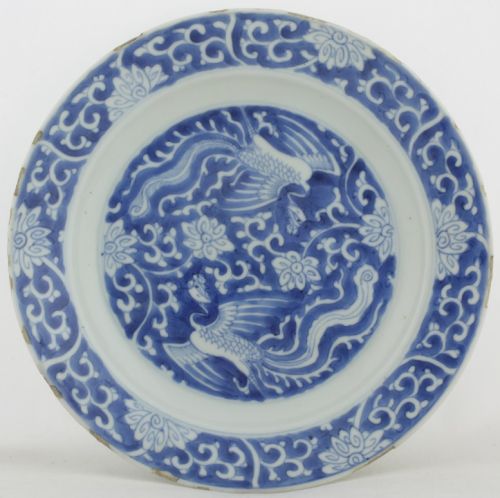
Sold Ceramics - Sold Chinese wares formerly in the Collection of August the Strong - Page 1
Object 2011802
Dish
China
1700-1710
Provenance: Formerly part of the Dresden collection formed by Friedrich August or August the Strong, Elector of Saxony and King of Poland and inventoried between 1721 and 1735
Height 33 mm (1.30 inch), diameter 215 mm (8.47 inch), diameter of footring 104 mm (4.09 inch), weight 343 grams (12.10 ounce (oz.))
Dish on footring with a flat rim. Decorated in underglaze blue. In the centre a, very rare, decoration of two phoenixes divided by leafy scrolls and lotus flower heads on an underglaze blue ground. On the rim half lotus flower heads flanked by leafy scrolls on a underglaze blue ground. On the reverse five precious objects. Marked on the base with a shop-mark in a double circle, underglaze blue. On the base incised with the Palace number (formerly called Johanneum mark) 'N:249.' and the signum '~'.
Dishes decorated with the Dragon, the symbol of the emperor, are rare, but dishes decorated with two Phoenixes (the symbol of the Empress) are even rarer. (Sargent 2012, p.112, cat. 31)
For similarly decorated dishes, please see:
- Kraak porcelain. A moment in the history of trade, (M. Rinaldi, Bamboo Publishing Ltd, London 1989), p.104, Pl.94.
Sold Ceramics - Sold Kraak Porcelain wares 1570-1645 - Dishes - Page 1 - Object 2011046.

The incised number identifies dishes like these as part of the collection of Friedrich August I, The Strong, Elector of Saxony later August II, King of Poland, which he amassed in Dresden. Only a few pieces were added after his death in 1733 and in fact it became a 'closed' collection. (Jörg 2011/2, p.52)
A special feature of the Dresden Porcelain Collection is comprised by the surviving eighteenth century inventories. The first inventory from the year 1721 (Inventarium über das Palais zu Alt-Dresden), mentioned above lists both the porcelain displayed at the Japanese Palace and the acquisitions till 1727. The porcelain was allocated to different groups, given a number and described briefly, giving measurements. The number was incised or painted on the bottom of the object. In order to distinguish the different groups a 'signum', or symbol, was added to the number. (Japanese porcelain had the signum of a cross). Besides information of the individual pieces, we find in the inventory remarks regarding circumstances of acquisitions ad losses. (Ströber 2005, pp.48-57)
Condition: Extensive glaze fritting and three chips, one with a short, connected hairline, to the rim.
References:
Goldsmith Phillips 1956, pp.48-50
Jörg & Van Campen 1997, cat 93
Pietsch, Loesch & Ströber 2006, pp.5-10
Price: Sold.


 create websites
create websites